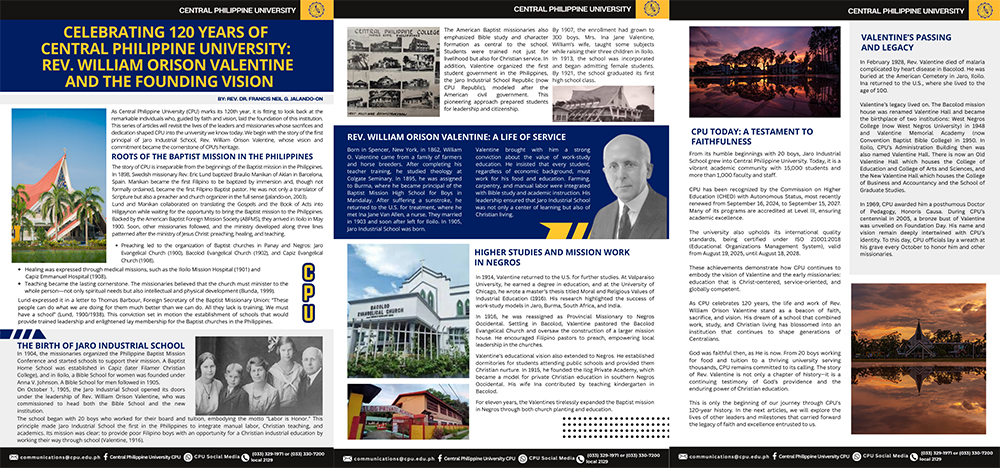By Rev. Dr. Francis Neil G. Jalando-on
Central Philippine University (CPU) is turning 120 years old this coming October 1, 2025. To God be the greatest glory!
As Central Philippine University (CPU) marks its 120th year on October 1, 2025, it is fitting to look back at the remarkable individuals who, guided by faith and vision, laid the foundation of this institution. This series of articles will revisit the lives of the leaders and missionaries whose sacrifices and dedication shaped CPU into the university we know today. We begin with the story of the first principal of Jaro Industrial School, Rev. William Orison Valentine, whose vision and commitment became the cornerstone of CPU’s heritage.
Roots of the Baptist Mission in the Philippines
The story of CPU is inseparable from the beginnings of the Baptist mission in the Philippines. In 1898, Swedish missionary Rev. Eric Lund baptized Braulio Manikan of Aklan in Barcelona, Spain. Manikan became the first Filipino to be baptized by immersion and, though not formally ordained, became the first Filipino Baptist pastor. He was not only a translator of Scripture but also a preacher and church organizer in the full sense (Jalando-on, 2003).
Lund and Manikan collaborated on translating the Gospels and the Book of Acts into Hiligaynon while waiting for the opportunity to bring the Baptist mission to the Philippines. Backed by the American Baptist Foreign Mission Society (ABFMS), they arrived in Iloilo in May 1900. Soon, other missionaries followed, and the ministry developed along three lines patterned after the ministry of Jesus Christ: preaching, healing, and teaching.
- Preaching led to the organization of Baptist churches in Panay and Negros: Jaro Evangelical Church (1900), Bacolod Evangelical Church (1902), and Capiz Evangelical Church (1908).
- Healing was expressed through medical missions, such as the Iloilo Mission Hospital (1901) and Capiz Emmanuel Hospital (1908).
- Teaching became the lasting cornerstone. The missionaries believed that the church must minister to the whole person, not only spiritual needs but also intellectual and physical development (Bunda, 1999).
Lund expressed it in a letter to Thomas Barbour, Foreign Secretary of the Baptist Missionary Union: “These people can do what we are doing for them much better than we can do. All they lack is training. We must have a school” (Lund, 1900/1938). This conviction set in motion the establishment of schools that would provide trained leadership and enlightened lay membership for the Baptist churches in the Philippines.
The Birth of Jaro Industrial School
In 1904, the missionaries organized the Philippine Baptist Mission Conference and started schools to support their mission. A Baptist Home School was established in Capiz (later became Filamer Christian University), and in Iloilo, a Bible School for women was founded under Anna V. Johnson. A Bible School for men followed in 1905.
On October 1, 1905, the Jaro Industrial School opened its doors under the leadership of Rev. William Orison Valentine, who was commissioned to head both the Bible School and the new institution.
The school began with 20 boys who worked for their board and tuition, embodying the motto “Labor is Honor.” This principle made Jaro Industrial School the first in the Philippines to integrate manual labor, Christian teaching, and academics. Its mission was clear: to provide poor Filipino boys with an opportunity for a Christian industrial education by working their way through school (Valentine, 1916).
The American Baptist missionaries also emphasized Bible study and character formation as central to the school. Students were trained not just for livelihood but also for Christian service. In addition, Valentine organized the first student government in the Philippines, the Jaro Industrial School Republic (now CPU Republic), modeled after the American civil government. This pioneering approach prepared students for leadership and citizenship.
By 1907, the enrollment had grown to 300 boys. Mrs. Ina Jane Valentine, William’s wife, taught some subjects while raising their three children in Iloilo. In 1913, the school was incorporated and began admitting female students. By 1921, the school graduated its first high school class.
Rev. William Orison Valentine: A Life of Service
Born in Spencer, New York, in 1862, William O. Valentine came from a family of farmers and horse breeders. After completing his teacher training, he studied theology at Colgate Seminary. In 1895, he was assigned to Burma, where he became principal of the Baptist Mission High School for Boys in Mandalay. After suffering a sunstroke, he returned to the U.S. for treatment, where he met Ina Jane Van Allen, a nurse. They married in 1903 and soon after left for Iloilo. In 1905, Jaro Industrial School was born.
Valentine brought with him a strong conviction about the value of work-study education. He insisted that every student, regardless of economic background, must work for his food and education. Farming, carpentry, and manual labor were integrated with Bible study and academic instruction. His leadership ensured that Jaro Industrial School was not only a center of learning but also of Christian living.
Higher Studies and Mission Work in Negros
In 1914, Valentine returned to the U.S. for further studies. At Valparaiso University, he earned a degree in education, and at the University of Chicago, he wrote a master’s thesis titled Moral and Religious Values of Industrial Education (1916). His research highlighted the success of work-study models in Jaro, Burma, South Africa, and India.
In 1916, he was reassigned as Provincial Missionary to Negros Occidental. Settling in Bacolod, Valentine pastored the Bacolod Evangelical Church and oversaw the construction of a larger mission house. He encouraged Filipino pastors to preach, empowering local leadership in the churches.
Valentine’s educational vision also extended to Negros. He established dormitories for students attending public schools and provided them Christian nurture. In 1915, he founded the Ilog Private Academy, which became a model for private Christian education in southern Negros Occidental. His wife Ina contributed by teaching kindergarten in Bacolod.
For eleven years, the Valentines tirelessly expanded the Baptist mission in Negros through both church planting and education.
Valentine’s Passing and Legacy
In February 1928, Rev. Valentine died of malaria complicated by heart disease in Bacolod. He was buried at the American Cemetery in Jaro, Iloilo. Ina returned to the U.S., where she lived to the age of 100.
Valentine’s legacy lived on. The Bacolod mission house was renamed Valentine Hall and became the birthplace of two institutions: West Negros College (now West Negros University) in 1948 and Valentine Memorial Academy (now integrated to other schools and become Convention Baptist Bible College) in 1950. In Iloilo, CPU’s Administration Building then was also named Valentine Hall. There is now an Old Valentine Hall which houses the College of Education and College of Arts and Sciences, and the New Valentine Hall which houses the College of Business and Accountancy and the School of Graduate Studies.
In 1969, CPU awarded him a posthumous Doctor of Pedagogy, Honoris Causa. During CPU’s centennial in 2005, a bronze bust of Valentine was unveiled on Foundation Day and this is now situated in the Rex D. Drilon Hall (CPU Administration building). His name and vision remain deeply intertwined with CPU’s identity. To this day, CPU officials lay a wreath at his grave every October to honor him and other missionaries.
CPU Today: A Testament to Faithfulness
From its humble beginnings with 20 boys, Jaro Industrial School grew into Central Philippine University. Today, it is a vibrant academic community with 15,000 students and more than 1,000 faculty and staff.
CPU has been recognized by the Commission on Higher Education (CHED) with Autonomous Status, most recently renewed from September 16, 2024, to September 15, 2027. Many of its programs are accredited at Level III, ensuring academic excellence.
The university also upholds its international quality standards, being certified under ISO 21001:2018 (Educational Organizations Management System), valid from August 19, 2025, until August 18, 2028.
These achievements demonstrate how CPU continues to embody the vision of Valentine and the early missionaries: education that is Christ-centered, service-oriented, and globally competent.
As CPU celebrates 120 years, the life and work of Rev. William Orison Valentine stand as a beacon of faith, sacrifice, and vision. His dream of a school that combined work, study, and Christian living has blossomed into an institution that continues to shape generations of Centralians.
God was faithful then, as He is now. From 20 boys working for food and tuition to a thriving university serving thousands, CPU remains committed to its calling. The story of Rev. Valentine is not only a chapter of history; it is a continuing testimony of God’s providence and the enduring power of Christian education.
This is only the beginning of our journey through CPU’s 120-year history. In the next articles, we will explore the lives of other leaders and milestones that carried forward the legacy of faith and excellence entrusted to us.
References
Bunda, N. D. (1999). A mission history of the Philippine Baptist churches, 1898–1998: From a Philippine perspective. Verlag an der Lottbek im Besitz des Verlags Mainz.
Jalando-on, F. N. G. (2003). A history of Philippine Baptist pastors, 1898–2002. Iloilo City.
Lund, E. (1900). Report to the Baptist Missionary Union. (As cited in Munger, 1938).
Munger, H. W. (1938). Baptists in the Philippines. The Chronicle, 1(4), 171.
Nelson, L. A., & Herradura, E. S. (1981). [Various references cited in the text].
Valentine, W. O. (1916). Moral and religious values of industrial education (Master’s thesis). University of Chicago.
Centralite. (2002). [Special issue], 32.
Report of Dr. Pulido to CPBC Assembly held at CPU, May 4, 1978. (As cited in Nelson & Herradura, 1981, p. 370).
Barbour, T. (1904, September 27). Letter to Rev. William Valentine.
Philippine Baptist Mission Conference. (1904, June 13). Founding record.

